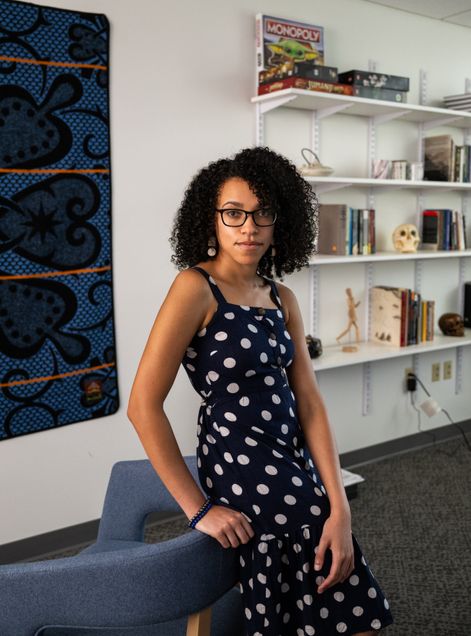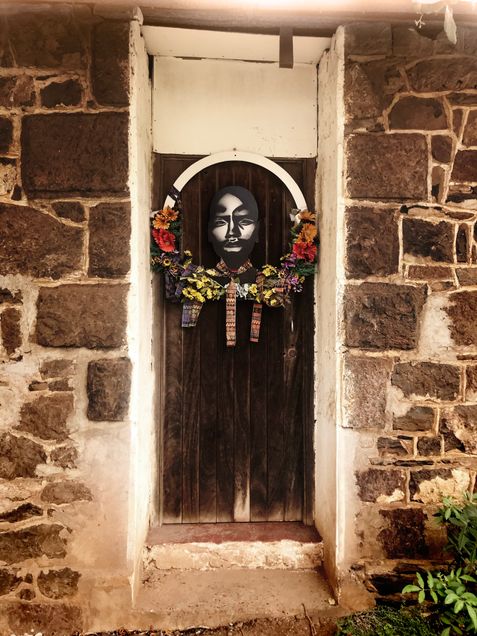Rewriting the Histories of Enslaved People
Anthropologist and archaeologist Andreana Cunningham wants to better understand the lives of people in the African diaspora—and to improve the ethics of her profession
In the mid- to late 1800s, the remote British overseas territory of Saint Helena was home to a community of “liberated Africans”—enslaved people from ships intercepted during the British Royal Navy’s suppression of the Atlantic slave trade and rerouted to the small island about 1,000 miles off the coast of Southern Africa.
Nearly a third of the African people who landed on Saint Helena died soon thereafter, the result of mistreatment on board the slavers’ ships. They were buried at the northern edge of the island, where their remains lay undisturbed until 2006, when workers began to build an airport access road. A team of archaeologists was called in to assess the extent of the gravesite and, after more than 300 complete skeletons were exhumed—a mere fraction of those buried in the area—the road was moved elsewhere.
The excavated remains were held in storage and made available for a limited number of research projects—including one by Andreana Cunningham, an assistant professor of archaeology, anthropology, and African American and Black diaspora studies.

Cunningham was curious about diaspora communities that formed during and after the transatlantic slave trade. Who was moved, and to where? How did those origins help shape (or not) the identities of African descendants in the Caribbean, or South Atlantic regions, or communities along the Indian Ocean?
An expert in bioarchaeology—the archaeological study of human burial context—Cunningham pulls from a range of disciplines to piece together evidence of how enslaved people lived and how they carved out autonomy in an otherwise inhumane system.
In April 2022, Cunningham arrived on Saint Helena to take 3-D scans of the exhumed skulls. Cranial shape patterns, she says, can be used in some ways as proxies for genetic data, and so the scans offer a noninvasive way to identify where, broadly, a person came from. Cunningham also analyzed archival newspapers for clues about the people buried at each of these sites.
She compared that data to similar data she collected at the Newton Enslaved Burial Ground in Barbados, and the Iziko South African Museum in Cape Town, to identify how people were moved along common slave trade routes.
She found a much greater influence of southeastern African populations—Mozambique, in particular—among existing African diaspora populations along the Atlantic. This suggests that a larger swath of African communities was captured in the slave trade than researchers previously thought.
Cunningham also began to reckon with long-standing archaeological practices and pushed herself to better engage the communities who have real, ancestral claims over these burial sites. For the project at Saint Helena, that meant scrapping her original research plan and instead rebuilding a more ethical version, a process that spurred a new direction in her research.
 “The skeletons of the past can actually tell us a lot about the history of the individual they belong to,” Cunningham says. “The experiences that you go through can be marked on your body, literally. Things like stress, daily habits, nutrition, the places you come from—these are all things that can be recorded, to some extent, on your skeletal remains.”
“The skeletons of the past can actually tell us a lot about the history of the individual they belong to,” Cunningham says. “The experiences that you go through can be marked on your body, literally. Things like stress, daily habits, nutrition, the places you come from—these are all things that can be recorded, to some extent, on your skeletal remains.”
At Saint Helena, she was particularly struck by how young the population was—more than half of the people buried at the site were under 18, based on their patterns of bone fusion and dental eruption. It was a reminder, she says, “of how fleeting life could be in this environment.”
The broad insight was a kind of
lightning-rod moment for Cunningham, who was already interested in exploring ways to fill the gaps in the history of the slave trade—a history nearly universally recorded by enslavers that left little to no room for the stories and experiences of the enslaved people themselves.
“That especially appealed to me, as an Afro-descendant,” she says. “It felt like a way of being able to give voice to people who could no longer share their stories.”
Although her view on working with human remains has grown more nuanced and complex, the bedrock of her research remains the same: What can the people enslaved by this horrific trade tell us about the experience, even now? How do those stories, omitted from the history books, change how we might think about existing diaspora communities? And how do we explore and lift up those stories while respecting the people whose remains we’re studying?
Typically, to study human remains, a researcher will submit a proposal that outlines the justification for the researcher’s work, the methods they’ll employ, any funders that have signed on—fairly cut-and-dried stuff.
But since 2020, “the year of racial reckoning,” as Cunningham describes it, there’s been a major shift. “There have always been dissenters in our discipline advocating for us to do better, but 2020 was what pushed the rest of the field to follow suit,” Cunningham says. For African diaspora studies in particular, Black anthropologists have been prominent advocates for more ethical, community-grounded practice.
“There were people pushing for accountability from institutions—reasonably so—and putting pressure to grapple with the fact that they have a lot of skeletons in their collections that have dubious origins,” Cunningham says. “And disproportionately, in those collections, you have the skeletons of indigenous and Black people.”
That reckoning changed how Cunningham thought about the care she and others in her field were taking with the remains they studied.
“Up until that point, I think the way that care was framed in doing work with human remains was that you are respecting them by attempting to speak to their experiences that they can’t anymore. And you’re respectful by treating them carefully, and making sure that they stay intact, and that you’re not sharing the pictures online—things of that nature.”
But as those discussions in 2020 unfolded, Cunningham says she developed a distinct discomfort with her ongoing dissertation work—work that was, by all accounts, by the book. She began questioning whether she was doing right by the people whose remains she studied. So she started over. She struck some of the data she’d already collected, decided that certain research collections weren’t appropriate to use at all, and created a whole new framework for her research.
Any sort of burial work, especially in an African diaspora context, should be done with community.
Historians, community advocates, communities with real or symbolic ancestors buried at these sites—these are all groups that she says need to be brought into any research context involving those remains. She maintains contact with these groups and makes her findings accessible to anyone who might be interested in them. Cunningham would also like to help to create a formal memorial and information center for the burial site. In 2022, just after her visit to Saint Helena, the the exhumed remains were reburied.
Now, she’s taking these experiences and applying them to the origins of human remains at BU.
Cunningham is working with Samantha Kelley (CAS’19, CAMED’22), the laboratory coordinator in the anthropology department, to trace back the acquisition of human remains that are part of BU’s teaching collection.
Working with students, their goal is a complete overhaul of the curation and documentation practices as they relate to the skeletal remains. It may turn out that some pieces need to be repatriated and reburied, or otherwise transitioned out of use from the teaching collection. Those decisions aren’t always clear-cut, Cunningham says; the process can be messy. But it’s an essential one for anyone in the fields of anthropology and archaeology.
For Cunningham, it’s also an opportunity to align her work with her values.
“It’s very much within the vein of placing ethics, ethical curation, and community at the heart of considering what research and teaching should look like,” she says.